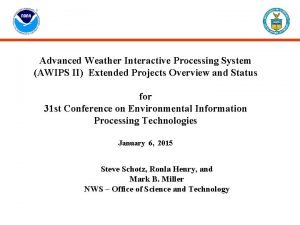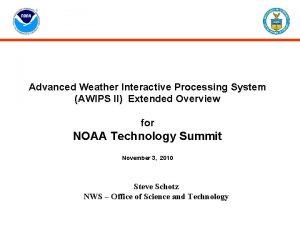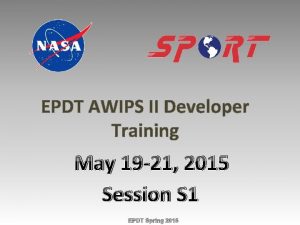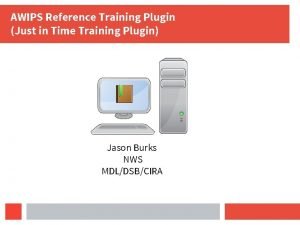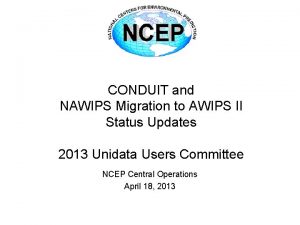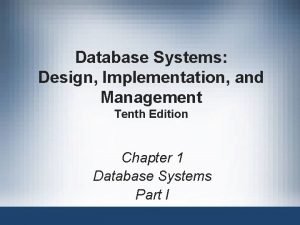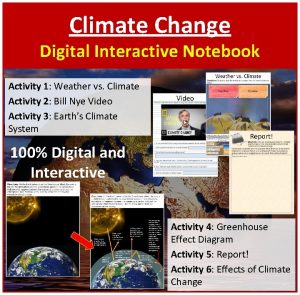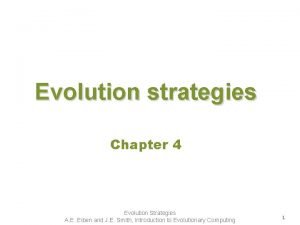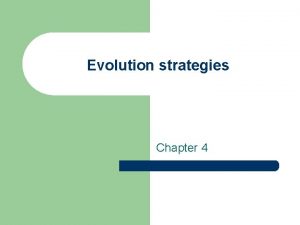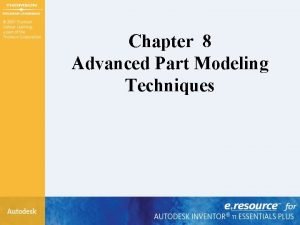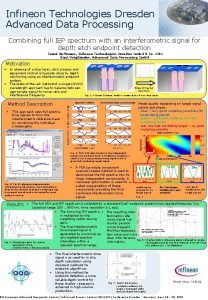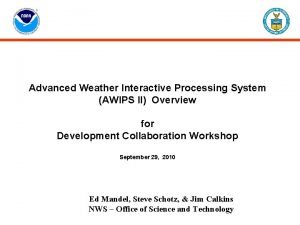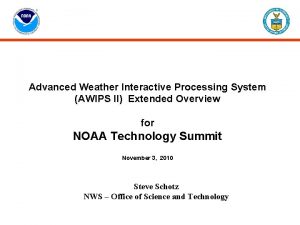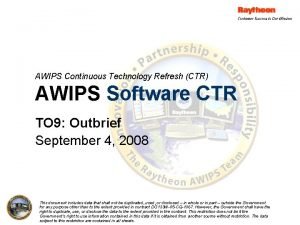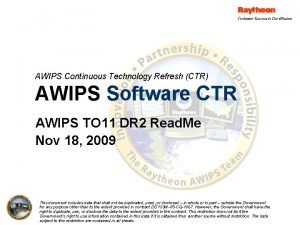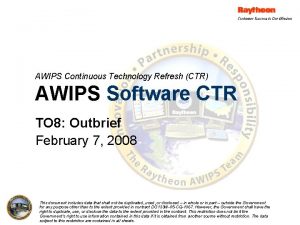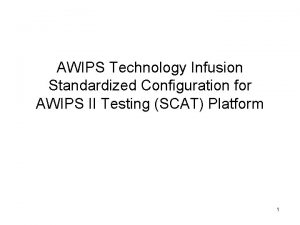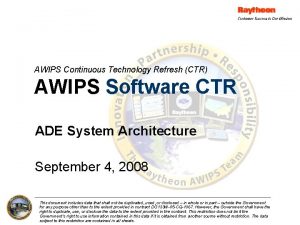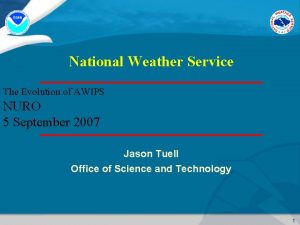Evolution of Advanced Weather Interactive Processing System AWIPS


















- Slides: 18

Evolution of Advanced Weather Interactive Processing System (AWIPS): AWIPS II Migration and Vision for the Next Decade 31 st AMS Conference on Environmental Information Processing Technologies January 6, 2015 Ronla Henry, AWIPS Program Manager NOAA/NWS, Office of Science and Technology

Outline • AWIPS Overview • AWIPS II Migration Project Status • Vision for the future 2

AWIPS Overview What is AWIPS? Advanced Weather Interactive Processing System (AWIPS) AWIPS is the NOAA/NWS cornerstone IT system used to ingest, analyze, forecast, & disseminate operational weather data, including time-sensitive, high-impact warnings to protect life and property …. . 24/7/365 3

AWIPS Overview AWIPS Locations 4

AWIPS Overview Scope & IT Footprint • Network Control Facility (NCF) operations – 24/7 Helpdesk, trouble shooting, repair, HW/SW installation support, continuous monitoring, and security patching – AWIPS Communications • Satellite Broadcasting Network (SBN): 30 Mbps satellite broadcast network; primary and backup Master Ground Station plus 167 site ground stations • LAN: IPv 6 ready; Managed by AWIPS NCF • WAN: Private VPN over NOAANet (not part of AWIPS contract) • Hardware Maintenance & Refresh – 172 systems at 150 sites; over 3500 servers and workstations; hundreds of routers, firewalls, storage arrays and network switches • Software Maintenance and Support – 8 million of lines of AWIPS I code under CM control – 8 million lines of AWIPS II code under CM control • Includes 2 million lines of code for legacy applications • Configuration Management – AWIPS Configuration Control Board reviews and authorizes all Requests for Change to the AWIPS IT enterprise 5

AWIPS Overview Evolution of AWIPS • Late 80 s - early 90 s: AWIPS I developed to replace AFOS system - AFOS = Automation of Field Operations and Services (AFOS) • 1997: AWIPS I deployed • 2004: NWS review identified AWIPS software as major obstacle to meeting future mission requirements – Costly to maintain; Challenging to infuse new science and applications • 2006: NWS executed contract option for AWIPS II-related projects • 2011: AWIPS II Field OTE began • 2012 -2015: AWIPS II migration to National Centers and field offices AWIPS Port Functionality to Flexible Architecture AWIPS II Migration Extend Unified Baseline & Continue Functional Improvement AWIPS II Extended and S&T Infusion 6

AWIPS II Migration Objectives • Objectives: Migrate existing AWIPS capabilities to a modern, robust Services Oriented Architecture (SOA) in order to: – – – Unify stove piped applications into single framework Improve maintainability & stability via streamlined, extensible software Reduce maintenance costs Speed infusion of research to operations Improve public weather forecast accuracy and timeliness • Metrics for success: Migration of legacy to SOA expected to bring measureable benefits: – Reduce time to transition from 18 months to 9 months – Reduce software development time for new products by 50% – Increase software release frequency from 2 to 4 per year 7

AWIPS II Migration AWIPS II Software Re-Architecture Approach • Perform “black-box” conversion of AWIPS I functions to AWIPS II – Preserve existing functionality, “look and feel” on top of new Services Oriented Architecture (SOA) infrastructure • Thorough field validation and acceptance before deployment – Forecaster initial testing sessions; continuing/expanding in next phase • No loss of functionality – Deployed system current with deployed AWIPS capability • Use open source projects - No proprietary code – JAVA, Post. Gres, Qpid, Pypyies, Eclipse devel. environment, etc. • Objective is to make AWIPS II the platform for collaborative development with public, private, academic and international weather communities – Added useful functionality – Portable code base – No license fees; No copyright – Source code available to collaborators – Common development environment available to collaborators 8

AWIPS II Migration Current Deployment Status (as of Jan 2015) • AWIPS II currently supporting operations at: – – 42 (of 122) local Weather Forecast Offices (WFOs) 13 (of 13) regional River Forecast Centers (RFCs) 8 (of 8) national-level NCEP center sites 6 (of 6) NWS Regional Headquarters • WFO deployment timeline – – – Group 1 complete; exited 30 -day stability test on November 7, 2013 Group 2 complete; exited 30 -day stability test on February 24, 2014 Group 3 complete; exited 30 -day stability test on July 2, 2014 Group 4 complete; exited 30 -day stability test on October 15, 2014 Group 5 complete; exited 30 -day stability test on December 18, 2014 • General Deployment begins January 12, 2015 9

AWIPS II Migration WFO Locations Using AWIPS II 10

AWIPS II Migration RFCs/NCs Locations Using AWIPS II 11

AWIPS II Migration General Deployment Guidelines • Guidelines: – Scheduling accomplish similar to other AWIPS software releases • Installs typically Monday – Wednesday; Thursday is make-up day – Release installed is based on • Release accepted for operational deployment • Availability of ADAM release • Availability of variance training – Site responsible for ensuring readiness to install software • Approximate amount of time required for key activities – Local Application Migration: 60 -90 days – Variance Training: Training window (for each release) opens as soon as training is available (minimum of 30 -day prior to installation) – Installation: 6 -8 hours – Service Backup: 24 Hours (may be less) • MICs certify migration of local applications and completion of variance training by forecast staff prior to installation 12

AWIPS II Migration General Deployment Best Practices • Best Practices: – Work with Regional Focal Points to establish “buddy site” – Utilize pre- and post-installation checklists – Utilize ADAM to test out configuration, local applications, etc. – Take back operational responsibility as functionality checks out – Open Trouble Tickets whenever you encounter a problem – Ask for help via Trouble Tickets or awips 2 dev list server 13

Vision for Future Continuations from current Contract • Basic contract structure: – O&M contract to operate/maintain system across National enterprise; continue approach of building towards stable and predictable O&M costs – Product Improvement contract to provide upgrades (e. g. , Extended Projects) • Continued focus on operational reliability/performance, IT security, cost effectiveness, customer support • Continued system evolution to meet evolving requirements, as well as to meet Dept. Commerce, NOAA and NWS Strategic Objectives: – DOC: http: //www. commerce. gov/blog/2014/03/10/department-commercereleases-fy-2014 -2018 -strategic-plan – NOAA: http: //www. ppi. noaa. gov – NWS: http: //www. nws. noaa. gov/com/weatherreadynation 14

Vision for Future *Potential Changes with New Contract • Provide 24/7/365 O&M support to NWS operational entities • Adhere to Government Computer/IT Security standards and requirements. • Establish necessary governance and/or processes as the integrator of AWIPS baseline software. • Provide enhancements and maintenance of AWIPS baseline software. • Provide a distributed AWIPS development environment and necessary governance for collaborative development of AWIPS software. • Provide an AWIPS architecture that reduces the AWIPS hardware footprint such that the proposed solution maximizes performance and operational efficiencies. • Provide AWIPS architecture that allows the users to visualize anticipated increases in hydrometorological data required for support mission requirements. * This subset of potential changes are under consideration only. NO final decisions have been made 15

Vision for Future Key Acquisition Dates • January 2015 – Anticipated Draft RFP Release • February 3 -4, 2015 – Industry Day at the NOAA Center for Weather and Climate Prediction (NCWCP) Conference Center located in College Park, Maryland • March 2015 – Anticipated Final RFP Release • June 2015 – Proposal Due Date 16

Vision for Future Acquisition Points of Contact Contracting Officer – Kenneth Brumfiel, NOAA AGO • Kenneth. Brumfiel@noaa. gov • 757 -441 -3433 Acquisition Lead – Mark B. Miller, NWS OST • Mark. B. Miller@noaa. gov • 301 -427 -9271 Program Manager – Ronla Henry, NWS OST • Ronla. Henry@noaa. gov • 301 -427 -9277 Contracting Officer Representative – Beraq Azeem, OST • Beraq. Azeem@noaa. gov • 301 -427 -9239 AWIPS technical library • https: //vlab. ncep. noaa. gov/web/awips-technical-library/home/ 17

QUESTIONS ? ?
 Awips weather
Awips weather Awips weather
Awips weather Batch processing and interactive processing
Batch processing and interactive processing Awips download
Awips download What is awips
What is awips Unidata awips
Unidata awips Nawips
Nawips Evolution of file system data processing
Evolution of file system data processing Weather and climate interactive activities
Weather and climate interactive activities Ofdm
Ofdm Advanced evolution - chapter 4
Advanced evolution - chapter 4 Advanced evolution chapter 4
Advanced evolution chapter 4 Advanced part modeling
Advanced part modeling What is top down processing in listening
What is top down processing in listening Advanced image processing techniques
Advanced image processing techniques Advanced data processing
Advanced data processing Station model
Station model Tongue twister weather
Tongue twister weather Poem about weather and climate
Poem about weather and climate
